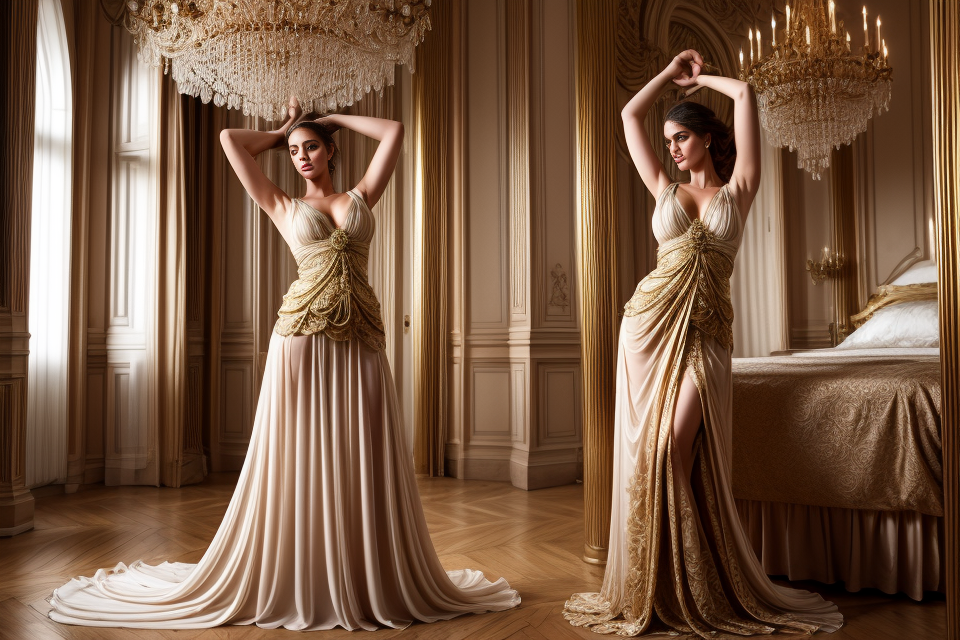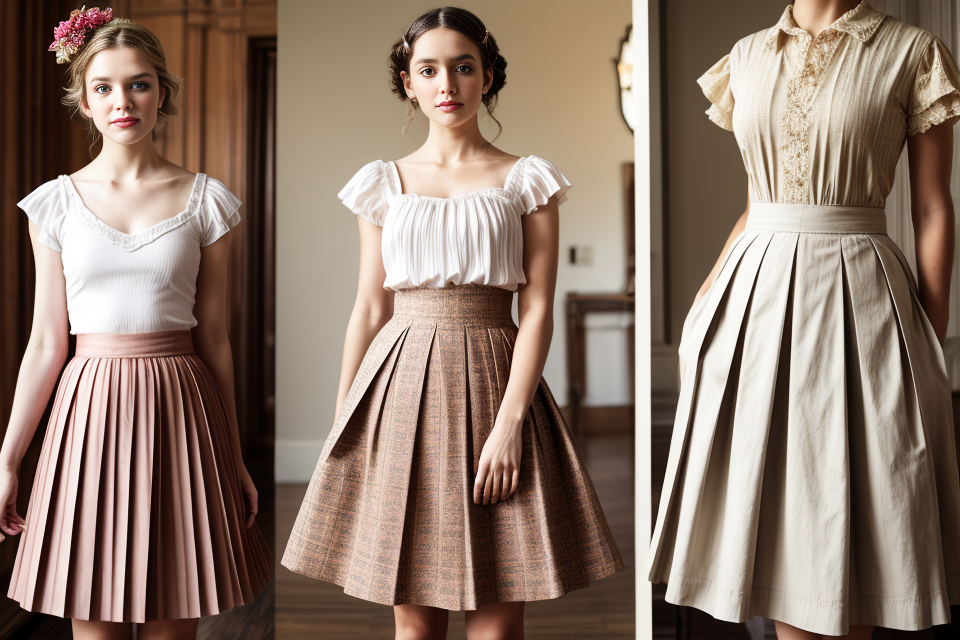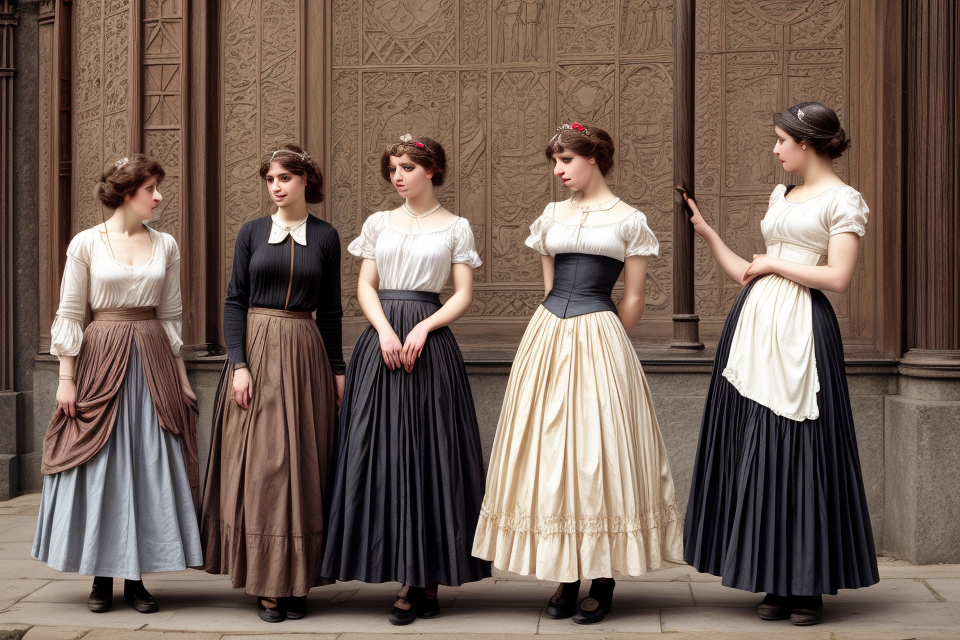Skirts have been a staple in women’s fashion for centuries, and they are often considered more modest than pants. But why is this the case? In this article, we will explore the history and cultural significance of skirts and why they are often seen as a more modest option for women’s clothing. From the traditional association of skirts with femininity and modesty to their role in societal expectations of gender roles, we will delve into the factors that contribute to the perception of skirts as more modest than pants.
Skirts are traditionally considered more modest than pants because they cover more of a woman’s body, particularly her legs, which are often considered to be more revealing than other parts of the body. Additionally, skirts are typically longer than pants, which further contributes to their modesty. This modesty is often valued in many cultures, particularly in conservative or religious communities, where revealing clothing is considered inappropriate or immodest. As a result, skirts are often seen as a more modest choice than pants, particularly in formal or professional settings. However, it’s worth noting that these perceptions of modesty can vary widely depending on cultural norms and personal beliefs, and that many people do not see skirts as inherently more modest than pants.
The history of skirts and modesty
Skirts have been a staple garment for women for centuries, and throughout history, they have been used as a symbol of modesty and femininity. In many cultures, skirts have been considered a more modest alternative to pants because they cover the lower body, which is often associated with sensuality and sexuality.
One of the earliest examples of skirts being used as a symbol of modesty can be traced back to ancient Greece, where women wore long, flowing robes that covered their entire body. These robes were made of lightweight materials like linen and were often accompanied by a cloak or shawl that could be draped over the shoulders to further cover the body.
In medieval Europe, skirts continued to be worn as a symbol of modesty and femininity. Women’s clothing during this time was often designed to emphasize their curves and create a more demure appearance. Skirts were typically made of heavy fabrics like wool and were often accompanied by a corset or other undergarment that helped to shape the body and create a more modest silhouette.
During the Victorian era, skirts became even more voluminous and were often paired with high-necked blouses and long sleeves. This was a time when modesty was highly valued, and women were expected to cover their bodies as much as possible. Skirts were often made of multiple layers of fabric, which helped to create a more modest appearance and hide any signs of femininity.
Today, skirts are still considered a more modest option than pants in many cultures. While the length and style of skirts have evolved over time, they continue to be associated with femininity and modesty. Many women choose to wear skirts as a way to express their personal style while still adhering to societal expectations of modesty and propriety.
Skirts as a symbol of femininity
Throughout history, skirts have been considered a symbol of femininity. This association has deep roots in societal expectations and gender roles. Women have traditionally been expected to dress in a way that emphasizes their femininity, which often includes wearing skirts or dresses. This expectation has been reinforced by cultural norms and media representations, leading to a strong connection between skirts and femininity.
The connection between skirts and femininity is further reinforced by the fact that skirts often have a more distinct feminine silhouette than pants. Skirts are typically designed to accentuate the curves of a woman’s body, while pants are generally more unisex in their design. This difference in design highlights the societal expectation that women should emphasize their femininity through their clothing choices.
Additionally, the association between skirts and femininity has led to the perception that skirts are more modest than pants. This perception is based on the idea that skirts cover more of a woman’s body, providing a sense of modesty and propriety. In contrast, pants are often seen as more revealing and immodest, particularly when worn by women.
Overall, the association between skirts and femininity has contributed to the perception that skirts are more modest than pants. This perception is based on the historical connection between skirts and femininity, as well as the design differences between skirts and pants.
Skirts as a cultural norm
Throughout history, skirts have been a common form of clothing for women, particularly in cultures where modesty is highly valued. The historical and cultural context of skirts has played a significant role in shaping perceptions of modesty.
One reason why skirts are often considered more modest than pants is due to the fact that they cover more of a woman’s body. In many cultures, the legs are considered to be a private and intimate part of the body, and exposing them in public may be seen as immodest or inappropriate. Skirts, on the other hand, cover the legs and provide a sense of modesty and privacy.
Additionally, skirts have often been associated with femininity and traditionally feminine roles. In many cultures, women have been expected to dress in a way that reflects their gender role, and skirts have been seen as a way to express femininity and adhere to traditional gender norms. This cultural norm has contributed to the perception that skirts are more modest than pants.
Furthermore, skirts have been a staple of formal wear for centuries, particularly in Western cultures. Formal events often require dresses or skirts, and these garments are often seen as more modest than pants or shorts. This cultural norm has carried over into other areas of life, and skirts are often seen as the more modest choice when it comes to choosing between pants and skirts.
Overall, the historical and cultural context of skirts has played a significant role in shaping perceptions of modesty. Skirts have long been associated with femininity, traditionally feminine roles, and modesty, and these associations have contributed to the perception that skirts are more modest than pants.
The influence of religion on skirt modesty
- The role of religion in shaping modesty standards
- Throughout history, religion has played a significant role in shaping societal norms and standards when it comes to modesty. Different religions have their own beliefs and guidelines regarding what is considered modest or immodest attire, and these beliefs have often influenced the clothing choices of followers.
- For example, in some conservative Christian communities, skirts are seen as a more modest option than pants because they cover more of the body and are believed to promote modesty and humility. In contrast, in some Orthodox Jewish communities, pants are considered more modest than skirts because they cover the legs, which are seen as being more sensitive and intimate.
- How different religions view skirt modesty
- Islam: In Islam, both men and women are expected to dress modestly and cover their bodies to avoid drawing attention to themselves. Skirts are generally considered to be a modest option for women, as long as they reach below the knee and do not reveal any form-fitting shape.
- Christianity: As mentioned earlier, in some conservative Christian communities, skirts are seen as a more modest option than pants. However, in other Christian denominations, such as the Baptist and Methodist churches, pants are considered to be a more modest option for women, as they are seen as being more practical and comfortable for everyday wear.
- Judaism: As mentioned earlier, in some Orthodox Jewish communities, pants are considered to be a more modest option than skirts. However, in other Jewish communities, skirts are seen as a more modest option for women, as they cover the legs and are believed to promote humility and modesty.
- Hinduism: In Hinduism, modesty is seen as an important virtue, and clothing choices are often influenced by this belief. Skirts are generally considered to be a modest option for women, as long as they are not revealing or tight-fitting.
- Buddhism: In Buddhism, modesty is seen as an important aspect of spiritual development, and clothing choices are often influenced by this belief. Skirts are generally considered to be a modest option for women, as long as they are not revealing or tight-fitting.
Pants and modesty
=====================
When discussing the topic of modesty, it is important to understand the cultural and historical contexts that have shaped societal norms surrounding clothing. Throughout history, different cultures have had varying attitudes towards the appropriateness of certain types of clothing for men and women.
In many Western societies, the way in which clothing covers or reveals the body has been used as an indicator of modesty. In this context, skirts have traditionally been considered more modest than pants because they cover the lower half of the body, which is often considered to be more private or intimate. This is particularly true for women, who have historically been expected to dress in a way that is less revealing than men.
Additionally, the length of a garment can also play a role in determining its modesty. Skirts that fall below the knee are often seen as more modest than those that are shorter, while pants that are fitted or form-fitting can be perceived as less modest than looser, more flowing pants.
It is important to note, however, that attitudes towards modesty and appropriate clothing can vary widely across different cultures and societies. In some cultures, pants may be considered more modest than skirts, while in others, the opposite may be true.
Overall, the concept of modesty is complex and multifaceted, and the way in which clothing is perceived can vary widely depending on a variety of factors, including cultural norms, personal beliefs, and individual preferences.
The rise of pants in fashion
The acceptance of pants as a fashionable choice for women’s clothing has a long and complex history. In the past, pants were considered to be a more masculine and practical garment, and were not commonly worn by women. However, as women’s roles in society have changed, so too has the perception of pants as a fashionable and appropriate choice for women.
One of the earliest recorded instances of women wearing pants was in ancient Greece, where women of the upper class would wear a type of pant known as a “pessa” or “pantalion.” These pants were similar to the loose-fitting trousers that were worn by men at the time, and were often made of lightweight materials such as linen.
However, it was not until the 20th century that pants became a popular choice for women’s clothing. During the early 1900s, women began to experiment with more comfortable and practical clothing options, such as the “bloomer” style of pants. These pants were loose-fitting and often worn with a waistband, and were seen as a more comfortable alternative to the restrictive and impractical corsets and skirts of the time.
As women’s roles in society continued to change, so too did the perception of pants as a fashionable and appropriate choice for women. In the 1960s and 1970s, pants became a symbol of feminist and gender equality movements, as women began to reject traditional gender roles and embrace more practical and comfortable clothing options.
Today, pants are a common and accepted choice for women’s clothing, and are often seen as a more practical and comfortable alternative to skirts and dresses. However, despite the widespread acceptance of pants as a fashionable choice for women, skirts are still often considered to be a more modest and appropriate choice for certain situations and settings.
Pants and modesty standards
- In many cultures and religions, pants are perceived as being less modest than skirts or dresses.
- This is because pants tend to cover less of the body, particularly the lower half, and may reveal more skin.
- In some cultures, such as those in the Middle East, pants are considered immodest for women and are often not worn in public.
- In other cultures, such as those in the Western world, pants are generally considered to be more modest than skirts or dresses, but this perception may vary depending on the style and length of the pants.
- Some religions, such as Christianity and Islam, have specific guidelines around modesty and may prohibit the wearing of certain types of pants, such as those that are too tight or revealing.
- The debate around pants and modesty is complex and varies widely depending on cultural and religious norms.
- Ultimately, the perception of pants as being more or less modest than skirts or dresses depends on a variety of factors, including cultural and religious beliefs, personal values, and individual preferences.
Skirt styles and modesty
============================
There are several reasons why skirts are often considered more modest than pants. One reason is the length of the garment. Skirts are typically longer than shorts or pants, which means that they cover more of the leg and are less revealing. Additionally, skirts are often made of materials that are more opaque, such as cotton or wool, which further contributes to their modesty.
Another factor that contributes to the modesty of skirts is the way they are worn. Skirts are typically worn with tops or blouses that cover the shoulders and chest, which helps to create a more modest appearance. In contrast, pants are often worn with tops that are more revealing, such as tank tops or crop tops, which can be less modest.
Finally, the cultural associations of skirts and pants may also play a role in their perceived modesty. In many cultures, skirts are seen as more feminine and therefore more modest than pants, which are often associated with a more masculine or athletic appearance. This cultural association may contribute to the perception that skirts are more modest than pants.
Different styles of skirts
A-line skirts
A-line skirts are characterized by a straight line from the shoulders to the hem, creating a shape that resembles the letter “A.” This style of skirt is considered modest because it does not accentuate the figure and provides a more demure appearance. Additionally, the cut of the skirt is typically such that it covers the thighs, which can be seen as more modest than shorter skirts that may reveal more skin.
Maxi skirts
Maxi skirts are a type of skirt that fall to the ankles or the ground, providing full coverage of the legs. This style of skirt is considered more modest than shorter skirts as it provides more material to cover the legs and provides a more conservative appearance. Maxi skirts can be worn in a variety of settings, from formal events to casual outings, and are often made of flowing fabrics such as chiffon or silk.
Mini skirts
Mini skirts are a type of skirt that are very short, typically falling above the knee or mid-thigh. This style of skirt is considered less modest than longer skirts as it reveals more of the legs and can be seen as more provocative. Mini skirts are often made of tight-fitting materials such as denim or spandex and are popular among younger individuals. However, it is important to note that wearing a mini skirt does not necessarily mean a person is immodest, as modesty is subjective and can vary depending on cultural and personal beliefs.
Modesty and skirt length
- The relationship between skirt length and modesty
- Skirt length is often used as an indicator of modesty, with longer skirts being perceived as more modest than shorter skirts.
- In many cultures, the length of a skirt is associated with the level of modesty and appropriateness for different settings and occasions.
- For example, in some traditional societies, skirts that reach the ankles or knees are considered modest, while skirts that are above the knee are seen as immodest or inappropriate.
- In contrast, in some modern cultures, skirts of any length can be considered modest or immodest depending on the context and the individual’s personal choices.
- How different lengths of skirts can be perceived as more or less modest
- The perception of skirt length as modest or immodest can vary greatly depending on the cultural context and individual beliefs.
- In some societies, skirts that cover the thighs are considered immodest, while in others, they are seen as appropriate and modest.
- Additionally, the perception of skirt length can change over time, as fashion trends and social norms evolve.
- For instance, in the past, shorter skirts were considered more modest than longer skirts, but today, shorter skirts are often seen as more revealing and less modest.
- Ultimately, the perception of skirt length as modest or immodest is subjective and can depend on various factors, including personal beliefs, cultural norms, and context.
Modesty and personal choice
In many cultures, modesty is a valued virtue, and it often manifests in the way people dress. In the context of clothing, modesty typically means covering the body in a way that is considered appropriate and respectful. The choice of clothing that an individual makes can reveal a lot about their values and beliefs, as well as their personal sense of style.
In discussing why skirts are often considered more modest than pants, it is important to consider the role of personal choice in the equation. While there are certainly cultural and societal factors that influence the way people dress, ultimately, individuals have the power to make their own choices about what they wear.
One factor that may influence a person’s choice to wear a skirt over pants is the desire to conform to social norms or expectations. In some cultures, skirts are seen as a more modest and appropriate choice for women in certain settings, such as in professional or formal settings. As a result, a woman may choose to wear a skirt as a way of adhering to these norms and expectations.
On the other hand, some individuals may choose to wear pants as a way of expressing their personal style or identity. Pants are often seen as a more practical and comfortable choice for everyday wear, and some people may prefer the freedom and comfort that comes with wearing pants.
Ultimately, the decision to wear a skirt or pants is a personal one, and it is influenced by a variety of factors, including personal style, cultural norms, and individual values and beliefs. While skirts may be considered more modest than pants in some contexts, the choice of what to wear ultimately belongs to the individual.
The impact of personal choice on perceptions of modesty
- Personal choice plays a significant role in shaping societal perceptions of modesty.
- Individuals have the freedom to make choices about their attire, which can impact how others perceive their level of modesty.
- These choices can be influenced by various factors, such as cultural norms, personal beliefs, and even the weather.
- For example, a person may choose to wear a longer skirt as a way to express their modesty, while another person may choose to wear shorts that are considered more revealing.
- It is important to recognize that personal choice is a key factor in determining what is considered modest or immodest.
- Different individuals may have different standards of modesty, and it is up to them to decide what they feel comfortable wearing.
- However, it is also important to consider the context and situation in which one is dressing.
- For instance, a more revealing outfit may be appropriate at a beach or pool party, but not at a formal business meeting.
- Ultimately, personal choice should be respected, as long as it does not harm or offend others.
The role of society in shaping personal choices
- Societal norms play a significant role in shaping personal choices when it comes to clothing.
- These norms are often influenced by cultural, religious, and historical factors.
- For example, in some cultures, it is considered more modest for women to wear skirts rather than pants.
- In other cultures, it is the opposite, and pants are considered more modest than skirts.
- Societal expectations can impact perceptions of modesty, leading individuals to make certain clothing choices based on what is considered appropriate in their social circle or community.
- For instance, in some conservative communities, wearing pants may be seen as immodest or inappropriate for women, while in more liberal communities, wearing skirts may be viewed as outdated or restrictive.
- It is important to note that personal choices regarding modesty are not always solely based on societal expectations, and individuals may have their own unique perspectives and reasons for choosing to wear certain types of clothing.
FAQs
1. Why are skirts considered more modest than pants?
Skirts have been traditionally considered more modest than pants because they cover more of a woman’s body, particularly her legs. In many cultures, it is believed that the legs are an intimate part of the body and should be covered to maintain modesty and respect for cultural norms. Skirts also tend to be longer than shorts or pants, which further contributes to their modesty.
2. Is it true that skirts are more comfortable than pants?
Comfort is a subjective matter and can vary from person to person. Some people may find skirts more comfortable than pants, while others may prefer pants over skirts. However, it is worth noting that skirts are generally more flexible and allow for better air circulation, which can make them more comfortable in hot weather.
3. Are skirts more feminine than pants?
Traditionally, skirts have been associated with femininity and are often seen as a symbol of femininity in many cultures. However, this is a societal construct and does not necessarily mean that skirts are inherently more feminine than pants. Both skirts and pants can be worn by people of any gender and should be chosen based on personal preference and comfort.
4. Is it necessary to wear skirts to be modest?
No, it is not necessary to wear skirts to be modest. Modesty is a personal choice and can be expressed through various clothing options, including skirts, pants, dresses, and more. What is important is that a person feels comfortable and confident in their clothing choices and that they respect the cultural norms of the environment they are in.



